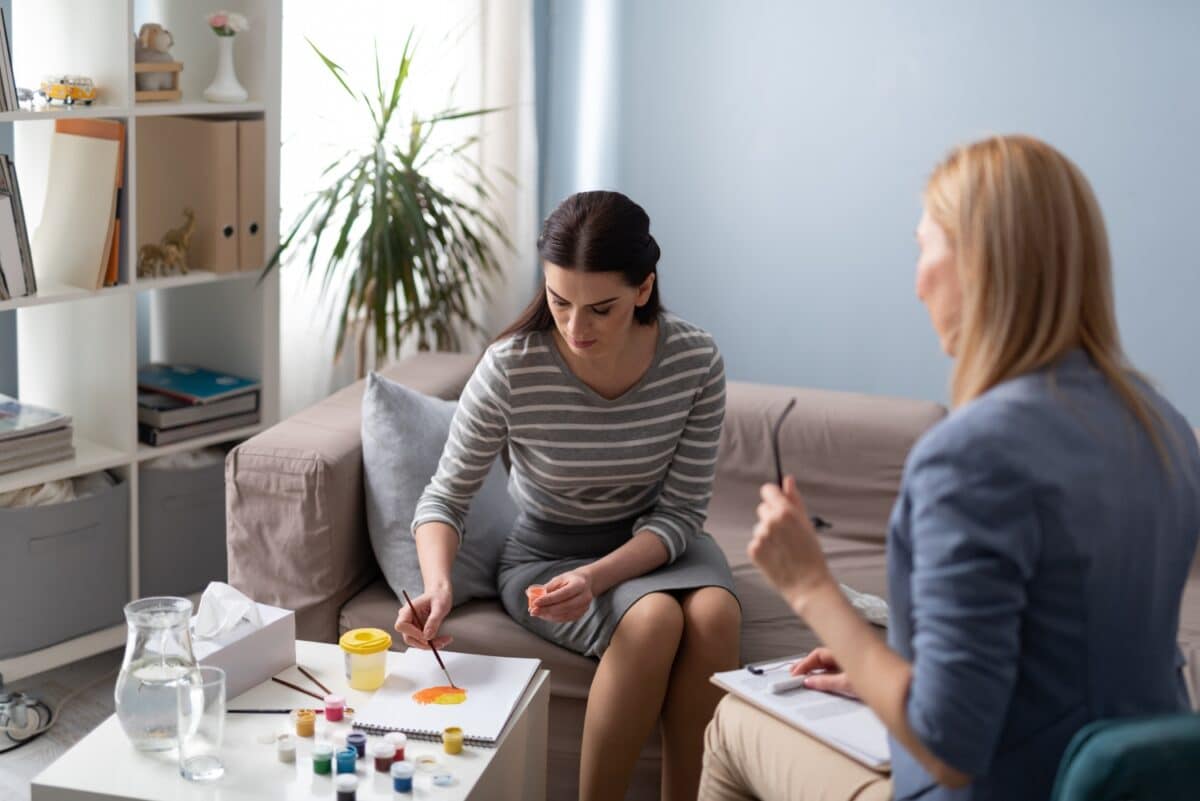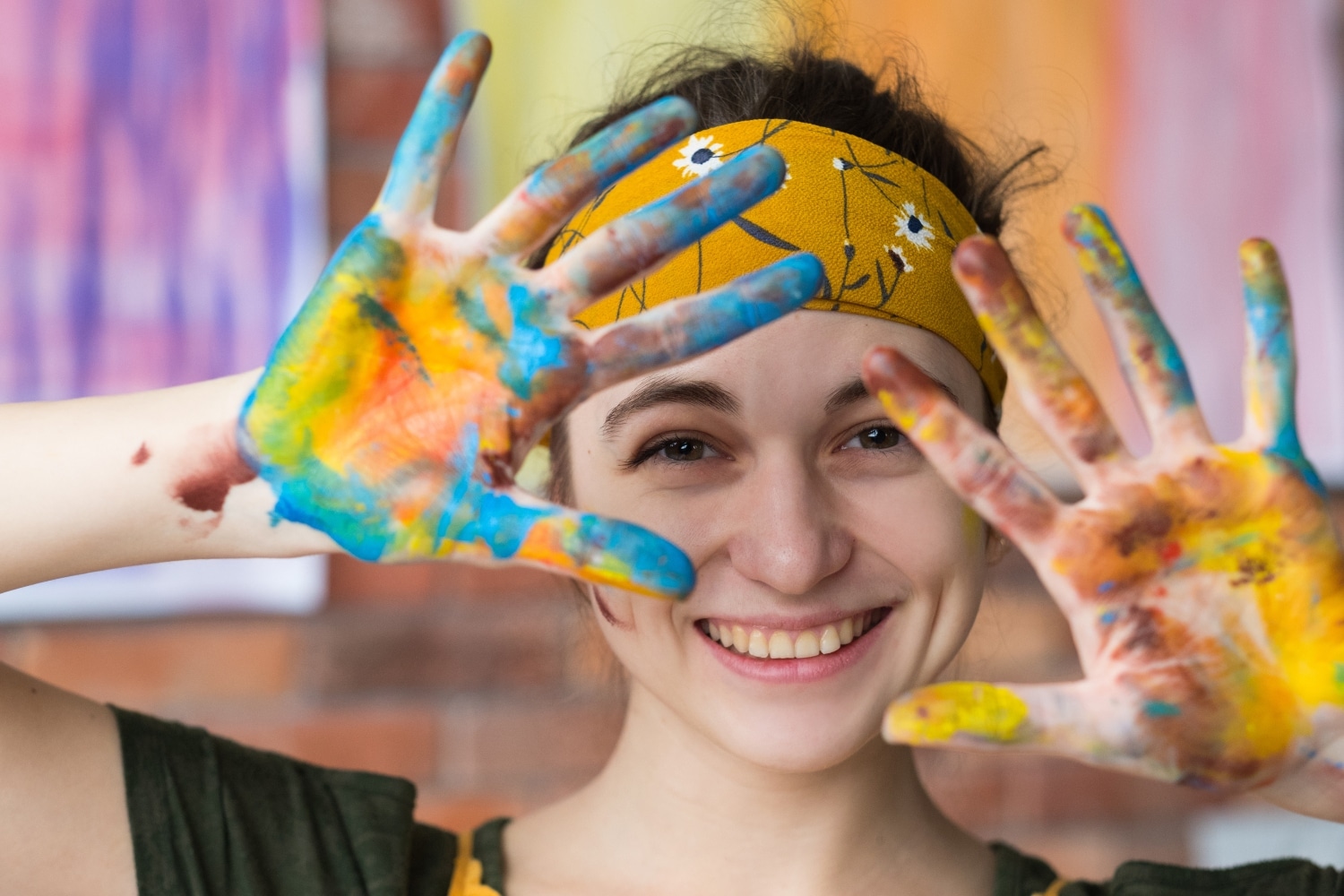Art therapy falls under the broader category of ‘Expressive Arts Therapies’, which include writing, visual arts, music, drama, dance, and movement.
These therapies combine creative processes with psychology to help people more easily access, express, and explore their thoughts, feelings, and experiences – and are proven to support both mental and physical health.
While humans have naturally used creative processes – like dance, music, and painting – to express themselves and heal for many thousands of years, it’s only since the 1940s that expressive arts have been formally recognised as effective therapeutic tools.
They now play a valuable role in helping to assess, diagnose, and/or treat many mental health conditions. As a result, they are typically used across various settings, from schools, hospitals, mental health centres, prisons, disaster relief centres, and nursing homes, to drug and rehab programs.
In this article, we’ll take a closer look at what art therapy is, how it works, and its many benefits for mental and physical health and overall well-being.
What is art therapy?
Art therapy can involve a wide variety of creative methods, including drawing, pottery, painting, photography, colouring, sculpture and collage.
It’s used as a tool by therapists to help people access, express, and interpret their thoughts, feelings, and experiences. It can help with gaining clarity on difficult issues and achieving deep healing.
Art therapy is especially beneficial for those who struggle to express themselves in traditional therapeutic settings, like talk therapy. It offers an alternative way to tap into their inner world and create a dialogue with the therapist either verbally or through the emerging artwork.
It provides a safe form of emotional release and communication in ways that the spoken language can’t always accomplish.
The focus during an art therapy session is heavily on the process of creative expression rather than on producing a particular piece of artwork or learning a specific technique. Therefore, no creative skills or previous art knowledge are needed.
Through the art they create, individuals can discover insights about themselves, gain valuable new perspectives, and find relief from any overwhelming emotions, crises, or trauma. At the same time, the art therapist gains a greater understanding of the individual’s functioning, challenges, resources and adaptability – to better inform the treatments they will benefit from moving forward.
Through engagement with the art materials and the therapist (in a safe and creative space), the mind, body and spirit are engaged, and personal growth and healing are made possible.
Art therapy has been shown to help people more effectively:
- express and interpret their thoughts and emotions
- gain personal insights, including different aspects of their personalities
- manage stress and anxiety symptoms
- develop new coping skills, including social skills
- boost self-awareness and self-esteem
- find resolutions to thoughts, feelings or issues causing them distress
- experience personal transformation.
For maximum effect, art therapy is typically used as a therapeutic tool alongside other therapy techniques, as part of a holistic treatment program, including Cognitive Behaviour Therapy (CBT), Group Therapy, and Eye Movement Desensitization and Reprocessing Therapy (EMDR).
How does art therapy work?

When an individual is experiencing intense, complex or confusing emotions, an art therapist can work with them to uncover what is causing them distress.
Through creating art under the therapist’s gentle guidance, the individual can address traumatic or uncomfortable situations without having to use words, which can, in turn, help nurture personal growth and healing transformation.
Art therapy professionals are trained in both visual arts and psychology and should ideally be registered with the National Art Therapy Credentials Board.
A typical art therapy session will follow three key steps, during which the therapist will:
1. Pre-art making
- Assess the client by gathering information from them.
- Establish what they need help with and agree on the therapeutic goals of the therapy session.
- Explain the process and reinforce that the client doesn’t have to be artistic or creative to benefit.
2. Art making
- Help the client select an art medium – such as collage, painting, drawing, or sculpture – most suitable for their situation.
- Discuss a theme that the client can create art based on, e.g. anger.
- Guide the client, usually by asking questions, to express themselves through the art as it is being created. However, the therapist’s primary role here is to observe – so there may be long periods of silence while the client creates.
- Answer any questions about how to use specific art materials.
3. Post-art making
- Discuss the results – both the final artwork and how the client felt/feels.
- Provide any psycho-education that is relevant to the topics discussed.
- Store the artwork safely so it can be referred to in the future – or take a photo of it to keep on file if storage isn’t practical.
- Plan another session to continue the therapy or for the client to work independently.
We’re here to help
Let’s talk
Call now for a totally confidential, no-obligation conversation with one of our professionals.
What is art therapy used to treat?
The American Art Therapy Association states that “art therapy can be an effective mental health treatment for individuals who have experienced depression, trauma, medical illness, and social difficulties”.
Further research shows positive results can be achieved when art therapy is used as a complementary therapy to treat many other conditions, including:
- attention deficit hyperactivity disorder (ADHD)
- anxiety
- problems with cognitive function
- eating disorders, including bulimia and anorexia
- psychological symptoms associated with medical issues, such as a disability or cancer
- trauma, including post-traumatic stress disorder (PTSD)
- psychological issues
- relationship/family issues
- stress
- substance use/dependency.
Art therapy can be a powerful tool in helping to assess, treat and improve various mental, physical and emotional health conditions – and can help relieve many of the associated symptoms.
What are the benefits of using art therapy?
There are many proven psychological benefits to be gained through using art in a therapeutic setting, shown to be effective for people of all ages and abilities.
More recently, researchers have also been exploring the benefits of art therapy for treating various physical health conditions – tapping into the mind-body connection.
Mental health benefits include:

- reduces symptoms of mental health issues, including stress, anxiety, and depression
- helps to reduce symptoms of psychological disorders, such as schizophrenia
- contributes to a sense of clarity, leading to greater self-awareness, boosting self-esteem and self-compassion
- provides a safe outlet for exploring and expressing feelings that may not be easy to speak about
- facilitates self-discovery and expression of underlying thoughts, ideas, and fears – especially helpful for those too traumatised to verbalise painful issues
- helps to develop social and interpersonal skills – especially when used in group therapy or family therapy settings
- helps bypass feelings of shame, fear, embarrassment, or resistance by allowing free expression through non-verbal techniques
- has a positive impact on self-regulating emotions – rage, guilt, pain, and other difficult feelings can be channeled through the art instead of ‘acting out’ behaviours
- increases brain connectivity and plasticity, increasing psychological resilience
- generates positive, creative energy as a healing force for the mind, body and soul.
Physical health benefits include:
- helps in chronic pain management, including arthritis and hypertension
- decreases pain and reduces symptoms of stress to improve the quality of life in adult cancer patients
- improves the ability to deal with pain and manage frightening symptoms in children with cancer
- reduces anxiety and stress in children with asthma
- stimulates mental function and reduces stress-related behaviours in dementia patients
- indicates a reduction in depression in Parkinson’s patients.
Art therapy for addiction recovery
Art therapy has not been shown to constitute adequate treatment for mental health disorders such as addiction when used in isolation. However, it is a clinical and evidence-based intervention that is proven to be a highly effective and valuable component of any treatment plan when combined with psychotherapy and medication.
Art therapy is a flexible approach that can be adapted for use at any stage of treatment for substance abuse, from detox and withdrawal to aftercare and recovery.
As part of a treatment plan for addiction, art therapy offers many benefits, including:
- working through trauma, underlying issues, and difficult life experiences in a safe way
- learning to understand and express emotions in healthy ways
- learning new ways to deal with stress, anxiety, and depression
- improving communication skills and relationships
- developing self-awareness, self-compassion, and self-esteem
- discovering new talents and interests that support recovery.
For those in rehab, art therapy can also provide a much-needed break from traditional therapies – which can be mentally and physically draining – allowing for some downtime to relax and recharge.
Art therapy at White River Manor
At White River Manor, we offer art therapy as part of our personalised treatment plans, using different methods to cater to individual needs and address various mental health and addiction aspects.
If you’d like to learn more about art therapy at our luxury and wellness centre, please contact us today for a confidential, no-obligation conversation with one of our mental health professionals.







